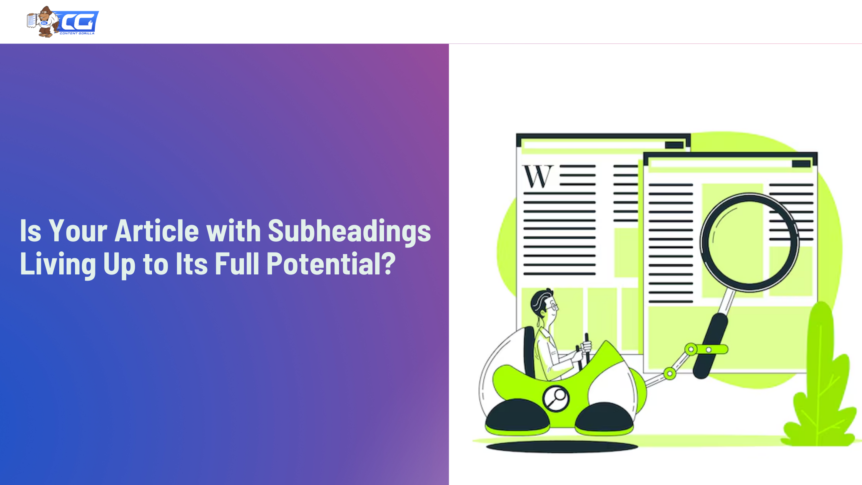In our series about headlines that grab attention, let’s dive into the importance of an article with subheadings. Granted that it’s very important to win the reader’s attention with your headline. The next crucial step is to craft resonating subheadings.
To elaborate, headlines get people to click and explore the content. But it is subheadings that keep them reading. Providing context, they elaborate on the topic in a catchy and supportive manner.
In this guide on articles with subheadings, we’ll explain what subheadings are and how they improve article structure. Then we’ll provide tips on writing effective subheadlines that complement the main headline and engage the reader. Let’s begin!
What Is a Subheading in Article Writing?
Source: Content Gorilla
The heading of an article introduces the core idea of the content. Following the main heading or H1, a subheading (H2, H3, etc.) is a secondary heading that appears within the article body. It breaks up the article’s content into smaller, more specific sections.
In plain terms, a subheading is a mini title for an individual section that goes deeper into the topic. It helps organize the content, making it easier for readers to navigate and skim the content.
Levels of Subheadings
There are different levels or types of subheadings. Let’s see the main ones below.
Heading level 2 (H2)
H2 subheadings break up the content under an H1 heading into main sections. They provide a clear structure for readers and search engines to scan through. Thus, they make it easier to navigate and understand the content hierarchy.
Heading level 3 (H3)
This is the third-highest level of heading. It is used to divide the content into smaller, more manageable sections under each H2 heading. An H3 enhances the readability and clarity factor. As a result, it ensures readers can easily follow the flow of ideas.
Heading level 4 (H4)
H4 headings, while seldom used, separate content into even smaller subsections under an H3 heading. They are used for highly detailed sections within H3s. Simply put, H4s are for complex H3s that require additional explanation.
💡Quick Tidbit: The H4 is very seldom followed by an even more nested H5. The content only extends to H5 when an even more comprehensive elaboration of an H4 is needed.
Why Is an Article With Subheadings Better?
Source: Freepik
To answer the question, “How do subheadings help the reader?”, let’s discuss below the interesting factors that contribute to improving the content structure. For instance, subheadings
- Organize content by breaking down the text into digestible chunks.
- Are your content’s backbone that adds structure + depth to your content.
- Provide enhanced readability, making it easy for the readers to spot useful info or scan the content.
- Are designed to retain attention, keeping the readers interested in reading more.
- Boost reader engagement, increasing dwell time and improving SEO.
Write Subheadings the Correct Way

Source: Freepik
Today, both readers and search engines have become adept at skimming articles for key points in subheadings. And professional blog writers are smart enough to present the info in a format their audience loves. Let’s check out the amazing tips below to help YOU write an effective article with subheadings.
Provide value.
Avoid the common mistake that trips up most content creators. They craft on-point H1 titles just like these attention grabbing headline examples which help them win the reader’s attention. But when it comes to subheadings, they don’t put in the needed effort. In reality, your subheadings should be crafted meticulously to be valuable, informative, and interesting.
Always make sure that the promise you make in your H1 title is followed through in your subheadings. This is key to offering value and keeping readers engaged. Remember, if you fail to do so, they’ll leave and find another article.
Be clear and relevant.
While refining subheadings, it’s very important to prioritize clarity and relevance. For this purpose, reassess your initial draft with a critical eye. Cut the words that make your subheadings fluffy and ensure to keep them concise yet effective.
It’s necessary to streamline them to directly address the needs and interests of the reader. Such meticulously curated subheadings can guide readers effectively through the content. This ultimately enhances the overall reading experience.
Make them properly nested.
Now your subheadings are valuable and relevant, right? It’s time to properly structure them with the aid of nesting. Subheadings need to be organized hierarchically within the content, with subheadings appropriately placed under their main headings.
This organization improves the readability + navigability of your content. It also creates a clear and logical structure. This makes it easier for readers to locate specific sections within the content.
Check out these headings examples to get a clear idea of how and where to place them properly.
Keep them consistent.
Be sure to keep subheadings consistent to maintain coherence in your content. It makes scanning and reading easier. Keep them similar in length and structure. Aim for 50-70 characters per subheading (that makes 7-10 words) to maximize effectiveness and readability.
Here’s another important factor — formatting. It includes font size, style, and alignment of the subheadings. Uniformly formatted subheadings become visually appealing and easier to navigate.
Test different versions of subheadings.
Experiment with different subheading ideas to find the most effective ones. Testing different versions helps you gauge their impact on readability and engagement. To curate unlimited subheadings, try using our Free Blog Outline Generator. This works the same way as our Free Blog Post Idea Generator helps you get the best SEO-friendly H1 titles.
By analyzing the performance of each version, you can refine your subheadings to resonate better with your audience. This iterative approach helps fine-tune the content to meet the readers’ requirements. Ultimately, it enhances their overall experience.
FAQs
What are the examples of subheadings in an article?
Here’s an easy example: the subheading (H2), “Key Benefits of Regular Exercise,” in an article titled (H1) ‘How to Integrate More Exercise Into Your Routine’. The H2 here gives a glimpse into the content that follows, aiding readers in navigating the article effortlessly.
How many subheadings should there be in an article?
The number of subheadings in an article varies based on the content’s length and complexity. It is recommended to include a subheading every 200 words to structure the content efficiently. Typically there are 2-4 subheadings in shorter articles and more in longer ones.
How does a subheading differ from a subtitle?
A subtitle provides additional context about the main title/ topic. On the other hand, a subheading is used within the content body. It divides sections within the text to guide readers and maintain organization. This aids in enhancing the overall structure of the content.
Wrap Up
Serving as pillars for your content, strong subheadings enhance the overall reading experience. They give readers a quick idea of what the article is about and why they should stay on the page instead of moving around to get the info they need.
Writing an effective article with subheadings is a skill that can be easily developed with practice. Make sure you follow the techniques outlined in this guide. Doing so will help you craft subheadings that not only support the headline but also add context and depth to your article.

I am a full-time online marketer, for over a decade now. Helped over 100,000+ people & generated well over $12M in online sales.

